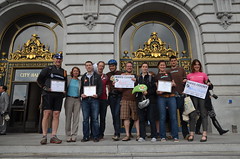Wednesday, October 22, 2008
| This article mentions the Wikimedia Foundation, one of its projects, or people related to it. Wikinews is a project of the Wikimedia Foundation. |
Monday saw the latest edition of the vetted version of Wikipedia, which is aimed at educational use, go quietly online. The extensively revised version covers over five thousand topics, targeting the eight to seventeen years age group. Partnerships with the Shuttleworth Foundation and the Hole in the Wall project will see it distributed in South Africa and India as well as copies being available globally via the offices of SOS Children UK’s umbrella organisation, SOS Kinderdorf worldwide.
First launched in 2006 as a 4,000 article edition, the extract of Wikipedia has employed hi-tech distribution methods, as well as offering a website version which has steadily climbed up in ranking to above other reviewed Wikipedia rivals and copies; the 2007 version was available on the BitTorrent peer to peer network to keep distribution costs down and was equivalent to a fifteen-volume printed encyclopedia. Monday’s release is compared to a twenty-volume print edition.
|
Our goal is to make Wikipedia accessible to as many people as possible around the world, and SOS Children is a great partner that helps us make that happen. |
|
|
Key to the process for selecting articles is the English National Curriculum and similar educational standards around the world. The initial vision was to bring this wealth of knowledge to schools where access to the Internet was poor or unavailable, but copies of Wikipedia for Schools can be found on many first world school intranets and web servers. Among the compelling reasons to adopt the project are the vetting and additional study materials which overcome the oft-publicised concerns many educators have with the million article plus Wikipedia that anyone can edit.
In today’s press release announcing the launch, Wikimedia Foundation Executive Director Sue Gardner expressed delight at seeing the project bring out a new version, “Our goal is to make Wikipedia accessible to as many people as possible around the world, and SOS Children is a great partner that helps us make that happen. Wikipedia is released under a free content license so that individuals and institutions can easily adapt, reuse and customize its content: we encourage others, like SOS Children, to do exactly that.”
Running 192 schools in the developing world, SOS Children sees Wikipedia for Schools as a key piece in fulfilling the educational aspect of their mission. SOS Children’s Chairwoman, Mary Cockcroft gave us an introduction and, a Wikipedia administrator himself, the charity’s CEO Andrew Cates spoke to Wikinews at length about the project.
You are part of SOS-Kinderdorf International, can you explain a little about how this works in terms of distributing funds raised in the UK and involving UK citizens in work outside the country?
Mary Cockcroft: SOS Children[‘s Villages] is a “club” of member charities in 130 countries helping orphans and vulnerable children. The club elects SOS-Kinderdorf International as secretary. SOS is a large organisation whose members in aggregate turned over $1bn in 2007, and whose projects include owning and running 192 schools and family-based care for 70,000 children. However much of these funds are raised locally, with for example the member charities in each of India, Pakistan and South Africa raise considerably more funds in their own country than SOS UK does from the UK. Nonetheless SOS Children UK principally raises funds to finance projects in the developing world, and has only financially small projects in the UK (such as the Schools Wikipedia, which is very low cost because of extensive use of volunteers). This year we expect about 80% of our UK income will leave the UK for overseas SOS associations, and some of the remaining 20% will pay for project oversight. We do not spend money in the UK on Direct Mail or TV advertising. Our UK office is involved in overseeing projects we finance and a small number of high-skilled volunteers from the UK help overseas. However around 98% of SOS staff worldwide are local nationals, as are most volunteers.
((WN)) How much work does the UK charity actually carry out within the home country? Are there failings within the government system for orphans and other needy children that you feel obliged to remedy?
MC: We are deeply unhappy about the situation of children in out-of-home care in the UK. However our care model of 168 hour-a-week resident mothers does not fit with the UK philosophy for children without parental care. Internationally SOS always has a policy of sharing best practice and we are working to improve understanding of our way of working, which appears to us to have far better outcomes than the existing one in the UK. Ultimately though the legal responsibility for these children lies with government and we cannot remedy anything without their invitation.
((WN)) Who first came up with the idea of doing a vetted Wikipedia extract? What was the impetus? Was it more for the developing world than first world?
Andrew Cates: I honestly cannot remember who first suggested it, but it came from somewhere in the Wikipedia community rather than from the charity. The original product was very much pitched at the developing world where the Internet is only available if at all over an expensive phone line. I worked in West Africa 1993-1996 and I know well at how thirsty for knowledge people are and how ingenious they will be in overcoming technical obstacles if the need for infrastructure is removed.
((WN)) In reading past year’s announcements there’s some pride in the project being picked up and used in the first world, was this expected or a pleasant surprise?
AC: It was a pleasant surprise. I don’t think we had realised what the barriers schools faced in using the main Wikipedia were. It isn’t just pupils posting material about teachers or meeting strangers: the “Random Article” button on every page could potentially deliver an article on hardcore porn. We had already started when discussion broke on banning Wikipedia from classrooms and I am sure we benefited from it.
((WN)) Can you give an outline of the selection and vetting process? Is it primarily Wikipedians working on this, or are people from the educational establishment brought in?
AC: It was a long and painful process, even with a really good database system. Articles were taken into the proposal funnel from three main sources: direct proposals for inclusion from Wikipedians, lists which came from the Release Version team and proposals drawn up from working through National Curriculum subjects by SOS volunteers. In a few cases where we felt articles were missing we asked the community to write them (e.g. Portal:Early Modern Britain, which is a curriculum subject, was kindly written just for us): These “proposals” were then looked at by mainly SOS volunteers (some onwiki, some offline). Our offices are in the middle of Cambridge and we get high quality volunteers, who skim read each article and then compared two versions from the article history by credible WP editors a significant period apart (this picks up most graffiti vandalism which runs at about 3% of articles). Once they had identified a “best” version they marked any sections or text strings for deletion (sections which were just a list of links to other articles not included, empty sections, sex scandals etc). A substantial sample of each volunteers work was then doubled checked for quality by one of two office staff (of whom I was one). We then have a script which does some automated removals and clean ups. Once we had a selection we posted it to relevant wikiprojects and a few “experts” and got any extra steers.
((WN)) Will you be making use of BitTorrent for distribution again this year? Was it a success in 2007?
AC: BitTorrent was a bit disappointing in that it got us the only substantial criticisms we received online. A lot of people find it too much effort to use. However for the period we offered a straight http: download we had huge problems with spiders eating vast bandwidth (the file is 3.5G: a few thousand rogue spider downloads and it starts to hurt). As per last year therefore our main two channels will be free download by BitTorrent and mailing the DVDs free all over the world. At a pinch we will (as before) put straight copies up for individuals who cannot get it any other way, and we have some copies on memory sticks for on distributors.
((WN)) Is it your opinion that the UK Government should be encouraging the adoption of projects like this as mainstream educational resources?
AC: Clearly yes. We have had a very enthusiastic reaction from schools and the teaching community. We think every school should have an intranet copy. We expect the Government to catch on in a few years. That is not to say that Wikipedia is as good as resources developed by teachers for teachers such as lesson plans etc. but it is a fantastic resource.
((WN)) You’re a Wikipedia administrator, all too often a thankless task. What prompted you to get involved in the first place? What are the most notable highs and lows of your involvement with the project?
AC: Funnily the thing I have found most amazing about Wikipedia is not widely discussed, which is the effect of Wikipedia policies on new editors. I have seen countless extreme POV new editors, who come in and try to get their opinions included slowly learn not only that there are other opinions to consider but that elements of their own opinion which are not well founded. Watching someone arrive often (on pages on religions for example) full of condemnation for others, gradually become understanding and diplomatic is one of the biggest buzzes there is. The downside though is where correcting things which are wrong is too painfully slow because you need to find sources. I was a post-doc at Cambridge University in combustion and I know the article on Bunsen burners has several really significant errors concerning the flame structure and flow structure. But sadly I cannot correct it because I am still looking around for a reliable source.
((WN)) Do you believe schools should encourage students to get involved contributing to the editable version of Wikipedia? Does SOS Children encourage those who are multilingual to work on non-English versions?
AC: I think older students have a lot to learn from becoming involved in editing Wikipedia.
((WN)) To close, is there anything you’d like to add to encourage use of Wikipedia for Schools, or to persuade educators to gain a better understanding of Wikipedia?
AC: I would encourage people to feed back to the project online or via the charity. The Wikipedia community set out to help educate the world and are broadly incredibly well motivated to help. As soon as we understand what can be done to improve things people are already on the task.
((WN)) Thank you for your time.


